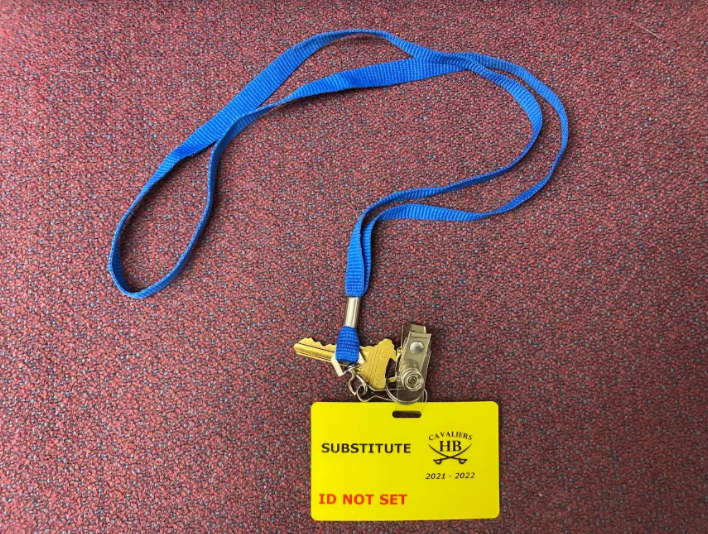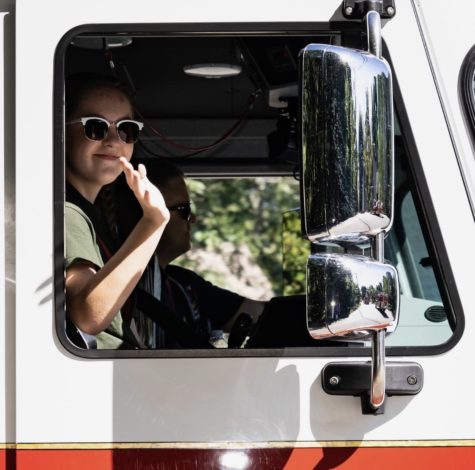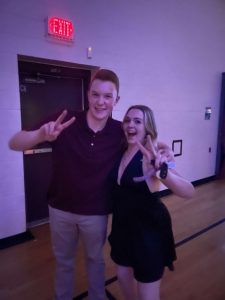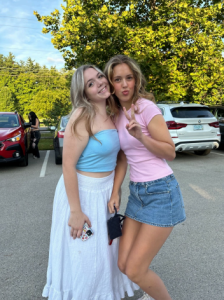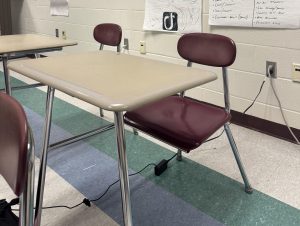How Short-Staffed Elementary Schools Affect Children’s Education
This substitute teacher badge shows that we have plenty of substitutes on hand when we need them. We are very lucky to have the staff that we do at Hollis/Brookline High School. Without them, the students would not be able to learn properly to prepare them for college.
March 10, 2022
Imagine, sitting in a classroom with your third substitute of the day, feeling like you aren’t learning anything, just doing the same work you have been doing for weeks. That is what most students are going through, country wide. Everyone is pitching in to help with staffing troubles, even governors and the National Guard according to CBS News.
The National Guard is not trained to be substitute teachers. The National Guard would probably be more helpful at Coronavirus testing or vaccine sites. Although it is helpful to have the bodies in schools, there are more important places for them to be.
Although this is not as much of an issue in the HB community, it is definitely a worldwide issue. Students nowadays feel like learning with a substitute can be harder than with their regular teacher. Students miss out on curriculum when they have a sub.“I definitely feel like I do miss out on some of the material in whatever unit we are on in the class, however, they can serve as good practice days for the material we are working on. It really depends on how the class is structured,” said sophomore Sarah Riseman. For example, when I personally have a substitute teacher in math class, we mostly just practice what we have just learned. It’s hard for a substitute to jump in and teach Trigonometry or Pre-calculus when they haven’t taken those classes themselves for years. This then sets us back a day in the curriculum and now we are scrambling to learn the new material before the test.
In the Nashua School District, schools closed for two days due to short staffing, really putting the classes behind schedule. “I had to change the dates for giving the formative and summative assessments for the current chapter and I start the next chapter later than expected. It doesn’t change much because we are adding those days to the end of the year,” said Rhonda Noe, a Health Sciences 1 teacher at Nashua High School South.
Nonetheless, it is hard to teach in a pandemic. There are so many platforms to learn during the pandemic, such as learning from home, learning from school, or alternating and going remote one day and in person the next. Imagine what your teachers are going through. Trying to do a science lab, when half your class is on Zoom and half your class is in the classroom is very hard. “It has been a very interesting two years. Initially it was very stressful to teach fully remote because I had to learn how to teach differently. I had to learn how to set up Google Classroom and then learn how to use it while having students on Zoom every day. Zoom was also a new learning tool for me. After a few days, it did get easier, but I noticed that many students were not working at their full potential. It was difficult to see some students fall behind because they couldn’t learn as well during remote learning and lots of students were affected with anxiety and depression,” said Noe. I don’t know how the teachers do it.
Some students can adapt to the teacher shortage better than others. First and second graders are trying to learn how to read but they can’t because their teacher isn’t there. High schoolers are able to work on classwork, practicing the things they are learning. Having lots of substitutes really does affect the students. “I would say that this is not really a concern here in our district. Across the country, there have been schools that have to shut down due to staffing, that have had to put out a notice to parents that, ‘we need to close today’. We are not going to see the effects of that until a little bit later. It depends on the grade level, it depends on the class, it will depend on the teacher, to see what that data looks like. I think a bigger overarching takeaway from this is all of the other impacts that the pandemic has on students. Over the course of the past two years, you have students across the country, who, you have staffing shortages, you have remote learning, you have parents who have lost their jobs or who haven’t been able to work because of the pandemic. You have families with health concerns due to the pandemic and all those other pieces. I think what we are going to see nationally, over the next few years, is how all of those things affected our students. It doesn’t really quite come down to staffing shortages for education, it’s all these other components, the fact that students who did stay home, and did not interact with their peers, how does that translate when they come back to school. So again, it’s a bigger question, and one that I don’t think we are going to see fully, the impact for another year or two,” said Lauren DiGennaro, Director of Student Services in the SAU 41 district.
Our district here at HB has been very lucky with staffing. We have had enough substitutes to cover the teachers who are out. We have also been very lucky that we haven’t had to close down our school due to staffing shortages like other nearby districts. We are very lucky to have the staff we do, our school wouldn’t be where we are today without them.



